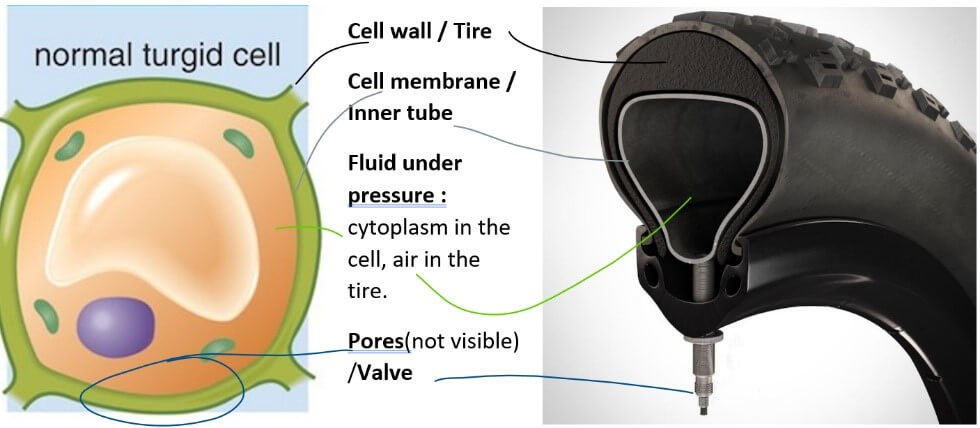Just like humans, plants also need water, a lot of it. We all learned in school that plants need water to create their own food, as water is a crucial part of photosynthesis. But, let’s have a closer look at what other functions water have in plants:
1) It transports dissolved nutrients from the roots up
2) Splitting of water, H2O generates the oxygen that we breathe and H+ for CO2 fixation.
3) and finally, water pressure keeps plants upright.
How does that work?
Plant cells are like tiny balloons or tires. They have a thin, but strong wall made of cellulose, which can resist pressure. Just like tires, when there is no pressure inside, they become soft and floppy, however, when pressurized, they can support hundreds of kilograms of car weight. Pressure of water inside plant cells is in fact comparable in size to the pressure in a car or a truck tire. The high pressure is generated by osmosis – the movement of water through the semi permeable cell membrane.

The inside of a cell contains a lot of substances – proteins, saccharides, nucleic acids and salts – which are attracting water, kind of like a sponge. Due to this strong attraction, water can flow inside the cells and generate pressure, which is higher than the pressure of surrounding air. The cell membrane contains selective pores called aquaporins, which let only water through and ensure that all the other substances stay inside of the cells. If plant cells are supported with enough water, they become inflated – turgid, however, if you forget to water them, or rain doesn’t come for a long time, they lose the pressure and cannot resist gravity. Fortunately, if you don’t leave it thirsty for a long time, a wilted plant can quickly recover.
That is exactly what happened to our plant. We got back home from a two-week holiday and found a very sad-looking plant in our apartment. In this 20 second time-lapse video you can see how quickly the plant recovered after we gave it some well needed water. The time lapse captures a period of 10 hours:
Can plant cells filter water?
Aquaporins are special proteins, present in plants, animals and some bacteria, that contain a narrow channel, only big enough to let water molecules through. Aquaporins were discovered serendipitously in the 1990’s and their discovery and characterization was awarded by a Nobel prize in 2003. Along the path inside aquaporin, several amino-acid side chains are passing water molecules to each other like a series of hands. Due to this selective mechanism, aquaporins selectively bind water and act as a nanoscopic filter.

Aquaporin inside
This very process can also be used industrially to purify water. Aquaporin proteins are synthesized by genetically modified bacteria and then embedded into thin sheets. This process is being developed and upscaled by a Danish company Aquaporin and marketed as a new generation of highly efficient forward osmosis membranes. Take a look at their exciting video and enjoy the world water day!
